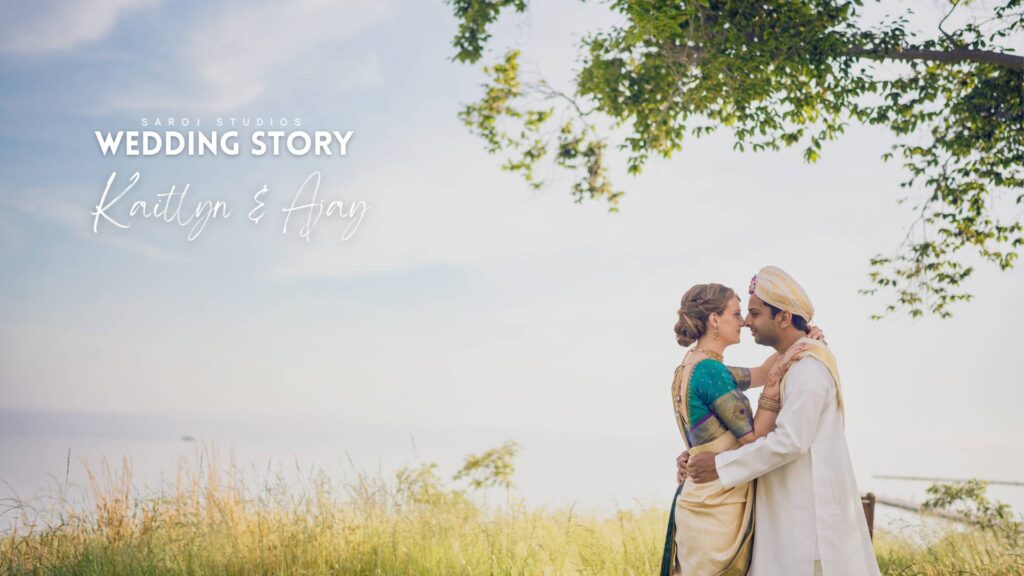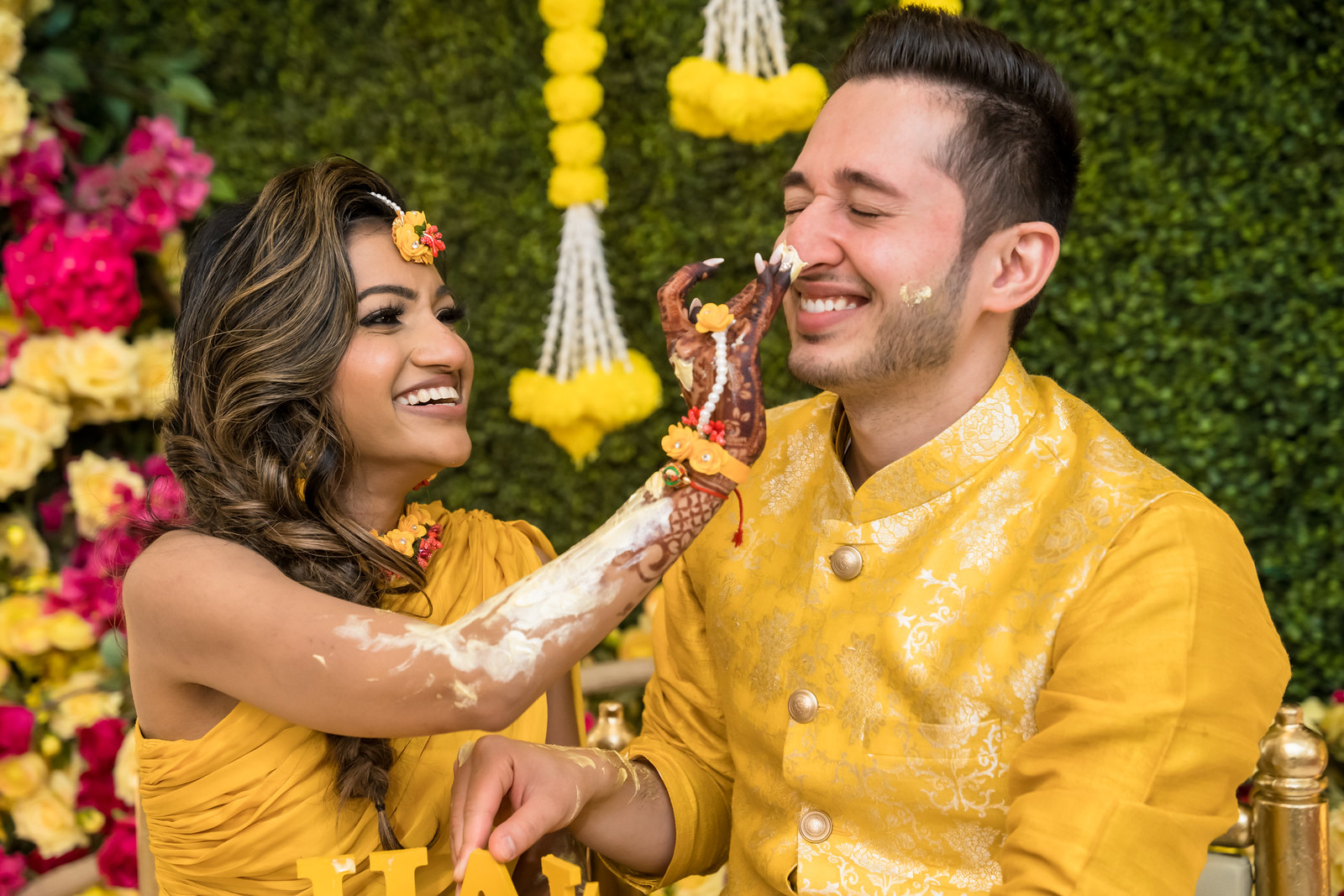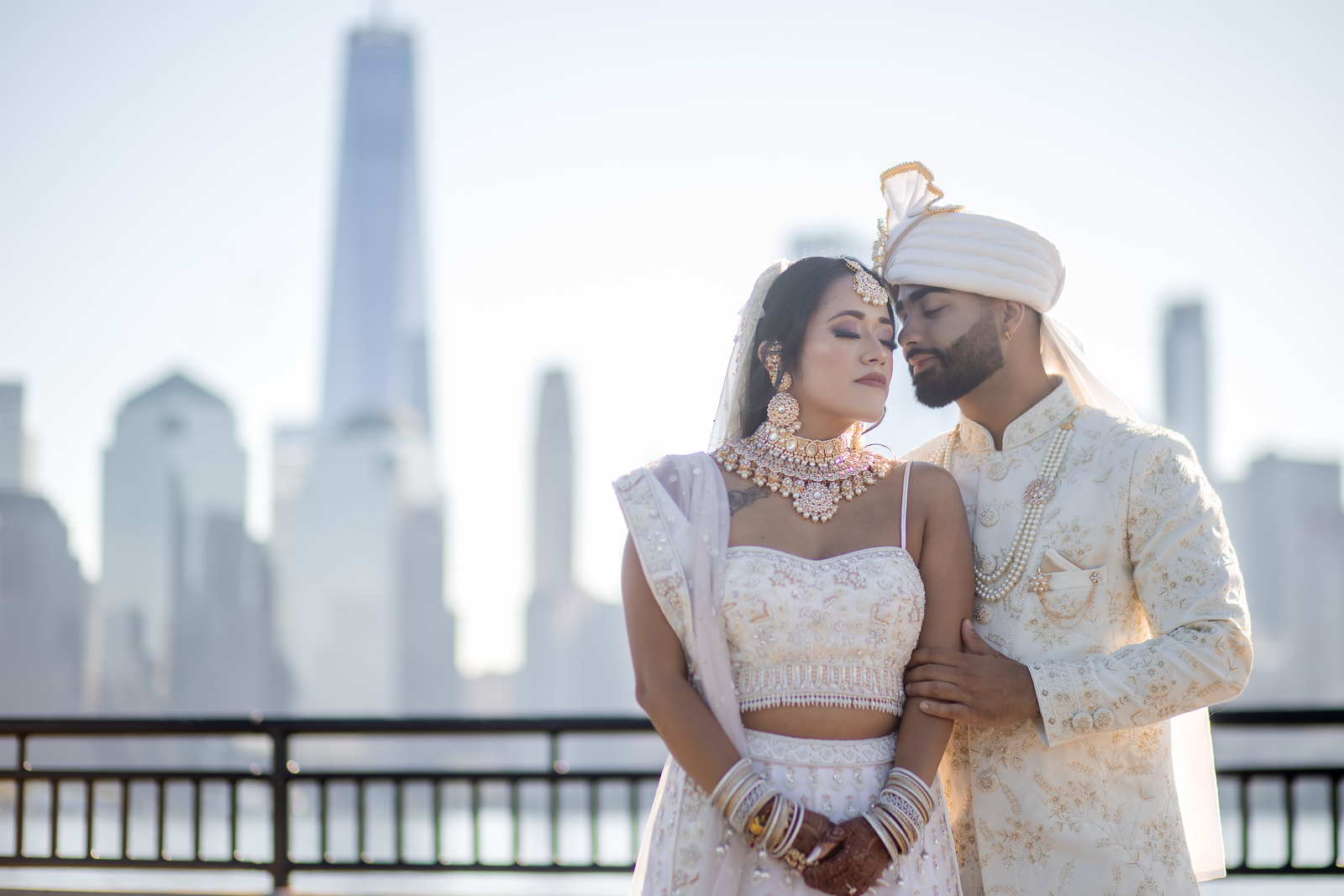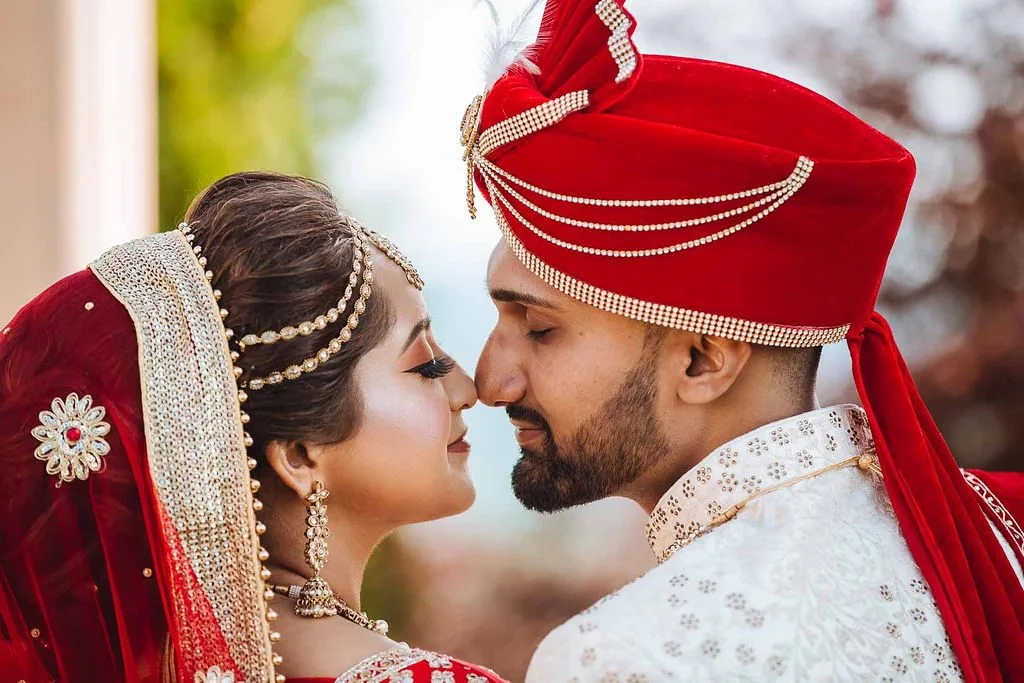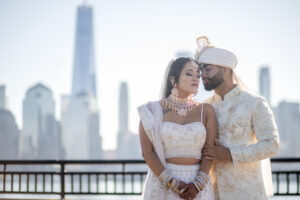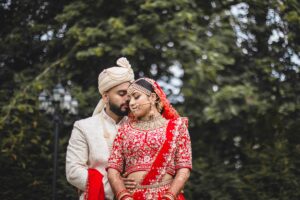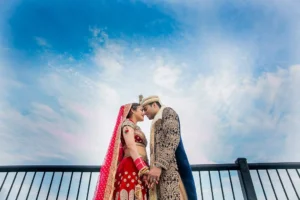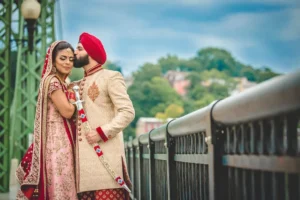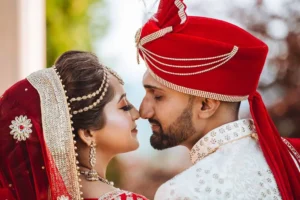Chandlo Matli, Saanjh Sandhya, and Aeki Beki are just a few of the vibrant traditions and practices that make up a Gujarati wedding. Look at all the wedding traditions in greater detail. When you see vivid Dhoti Kurtas, Bandhni dupattas and pagdis, stunning Chaniya Cholis, and Panetar sarees, you know it’s a Gujarati couple’s wedding because of the color scheme used throughout. A lot of rites and customs, delicious vegetarian food, lively folk music, and enjoyable wedding games.
A Gujarati wedding, never has a dull moment, from pre-wedding ceremonies to post-wedding festivities. Let us help you create a magnificent wedding keeping all the elements, culture, and traditions of Gujarati weddings alive.
Pre-wedding Rituals
A typical Gujarati wedding involves a number of pre-wedding rituals that are performed just before the wedding. Let’s take a look at the auspicious customs.
- Chandlo Vidhi
Gujarati refers to chandlo as a red vermillion. Tika and Matli are terms for money. In accordance with the Chandlo Matli tradition, the bride’s home is visited by the groom and four male family members. The groom is blessed and has the red Chandlo placed on his forehead by the bride’s father. The wedding date is also set at this time between the two families.
- Gol Dhana
In Hindi, the term “Gold Dhana” signifies jaggery with coriander seeds. Gold Dhana essentially depicts a Sagai ceremony or Engagement at a Gujarati wedding. With treats and presents, the bride and her family visit the bride’s family. After exchanging engagement rings, the pair asks for the approval of five married ladies from each family. Both families gather for a cozy feast featuring a variety of traditional Gujarati delicacies to mark the beginning of the wedding rites.
- Ganesh Matli or Ganesh Sthapna
A Gujarati wedding starts with the adoration of Lord Ganesha, just like most Hindu weddings and other customs. At the bride and groom’s respective homes, separate Ganesh Matli or Ganesh Sthapna ceremonies are held. A Ganesh Puja is performed in order to ask for blessings for a trouble-free wedding and a happy marriage.
- Griha Shanti
The family priests in both homes conduct another Puja addressing all the planets and stars immediately after the Mandap Mahurat. A Griha Shanti Puja is a vital necessity at a Gujarati wedding in order to guarantee the couple a happy and contented marriage. The main purpose of this puja is to steer clear of any potential astrological and planetary obstacles.
- Mehndi
The bride’s home hosts the Mehndi ritual two days before the wedding. The bride’s sisters, relatives, and friends, along with every woman in the family, gather to decorate their hands with mehndi. All the women chant and dance to folk tunes or Mehndi songs as the bride’s hands and feet are decorated with stunning henna designs.
- Sangeet Sandhya or Sanjhi
Sanji is a lively musical performance that Gujarati wedding guests virtually always anxiously anticipate! Both families come together during a Sangeet Sandhya or Sangeet ceremony to sing traditional songs and dance fervently to the Dandiya and Garba. The first time that both families get the chance to meet and get to know one another through music and dance is at a Sanji.
- Mandap Mahurat
Both families pray to Mother Earth for blessings at their respective houses on a Mandap Mahurat, also called a Mangal Mahurat. They pray to mother Earth and seek her blessing before performing the rite on the plot of ground where they would eventually build the wedding mandap.
- Pithi
In a Gujarati wedding, the bride and groom perform separate Pithi or Haldi ceremonies at their respective homes the day before the wedding. A paste made of turmeric, sandalwood, rosewater, and herbs is applied on the bride and groom’s faces and palms, as they sit on a low seat, called a bajat. The Pithi is customarily made by the wife of the groom’s or bride’s paternal uncle (Kaki). After applying the Pithi, the bride or groom has a holy bath.
- Mosalu and Mameru
Mameru/Mosalu, a ritual at Gujarati weddings, is comparable to Mahira Dastoor, a custom in Marwari weddings. A day before the wedding, the bride’s maternal aunt’s husband (Mousa) and her maternal uncle (Mama) pay her a visit at home. In accordance with tradition, Mama and Mousa present the bride with a classic Panetar saree, jewelry, an ivory Chura, sweets, dried fruits, and other items that are all elegantly wrapped in large trousseau trays.
Gujarati customs for weddings
Let’s now examine the Gujarati wedding customs that are followed on the big day:
- Varghodo
A Varghodo is a set of ceremonies performed before the groom enters the wedding location in a Gujarati wedding. The groom’s sister moves a bowl of coins she has been given by the family priest around the groom’s head a few times. The coin noises are meant to stave off bad spirits. This practice is also carried out by the sister of the groom to remind her brother not to forget his sister even if he is getting married. The groom and his family then proceeded to the location in a procession while singing and dancing.
- Jaan/Agaman
The Jaan rite is conducted to welcome the groom and his family as they arrive at the wedding location while riding on a mare that has been elegantly dressed. With sweets and Aarti, a Jaan or Agaman ceremony is specifically held to greet the groom’s family.
- Ponknu
An enjoyable ritual in Gujarati weddings is Ponknu. In essence, it symbolizes welcoming the husband to the mandap for the wedding. Before he enters, the bride’s mother performs Aarti, blesses him, and feeds him candy. She then tries to tug the groom’s nose in jest to remind him to be modest because he is come to ask their daughter’s hand in marriage. In response, the groom tries to elude the nose-pulling. Over time, everyone enjoys a good laugh as this ritual develops into one that is extremely humorous.
- Jaimala
The Jaimala procedure will begin once the bride and the husband have both arrived at the wedding mandap. Floral garlands are exchanged between the couple. There are occasionally Jaimala tunes playing in the background, and everyone applauds.
- Madhuparka
The bride’s mother accompanies the husband to the mandap for the following ceremony, known as Madhuparka, where she washes his feet with milk and water. She then presents Panchamrita, a drink made of milk, yogurt, sugar, ghee, and honey, to the groom. The bride’s sisters are planning and carrying out the entire Joota Chhupai rite at this time.
- Antarpaat
When the bride enters the mandap, a cloth called an Antarpaat is drawn between her and the groom. This custom is followed in Gujarati weddings to keep the couple from looking each other in the eye.
- Kanyadaan
Similar to most Hindu weddings, Gujarati weddings also adhere to the Kanyadaan custom of the bride’s father giving his daughter in marriage to the groom. He first washes the groom’s feet before asking the groom to take care of his daughter and delivering her to him with folded hands.
- Hasta Milap
By tying the groom’s shawl and the bride’s saree Palla, the wedding priest creates the holy knot, symbolizing the union of two souls. Along with joining their hands, he recites sacred mantras. By showering the pair with rice grains and rose petals, the entire family and extended family blesses them.
- Mangal Pheras
In Mangal Pheras, a couple makes four circuits around the sacred fire while chanting mantras that represent lifelong vows of fidelity. The four Pheras stand for, successively, “Dharma,” “Artha,” “Kama,” and “Moksha,” which are the four cornerstones of a good marriage. The bride’s brother presents them with puffed rice to sacrifice to the sacred fire after each round (similar to Khoi Fela).
- Saptapadi
Similar to other Hindu weddings, the Saptapadi rite is one of the most important parts of a Gujarati wedding. Now, the bride and groom take seven steps while exchanging seven holy matrimonial vows. The seven vows include the promises to cherish one another, care for one another, start a family, and spend all of eternity together.
- Kansar, Mangalsutra, and Sindoor daan
In a Gujarati wedding, the final three steps are as follows: The bride’s hair is first painted with vermillion (Sindoor) in the middle of the portion. The bride’s first symbol as a married lady is this. Then he fastens the sacred Mangalsutra around the neck of the bride. Last but not least, the newlyweds feed each other candy, a practice known as the Kansar. The newlyweds touch their elders’ feet to ask for their blessings as the wedding ceremony draws to a close.
Gujarati wedding customs following the ceremony
Most Gujarati wedding post-wedding ceremonies are straightforward and comparable to many other Indian wedding customs. To learn more, keep reading:
- Bhavna Saubhagya
The newlywed couple is invited to be blessed by seven married women. Each woman says to the bride, “Saubhagyavati Bhava,” which translates to “may your marriage life thrive with eternal splendor,” when the pair asks for their blessing.
- The Chero Pakaryo
In a somewhat amusing Gujarati wedding tradition, the husband grabs his mother-in-saree laws by the pallu and requests more presents. Then, everyone stuffs her saree pallu with money and presents, which are then given to the groom’s family. The couple is blessed by Ashirwad and Reception Members from both families, after which a reception supper is hosted in their honor. Everyone attends, officially congratulates the couple, and feasts heartily.
- Vidaai
The bride departs from her family house in an emotional Vidaai ritual after the reception is ended. She hurls rice at the home she is leaving from the back of her head. It serves as a metaphor for her repaying her family’s debts.
- Laxmi Ghar Nu
The bride’s mother-in-law extends a cordial greeting to her in her new residence. She welcomes the bride and conducts the couple’s Aarti. The bride is then expected to push a pot full with grain right up to the door and enter the home. In a Gujarati wedding, this is seen as an auspicious tradition and is thought to bring good fortune.
- Aeki Beki
The newlyweds’ favorite wedding game is called Aeki Beki. Milk, vermillion, water, money, and a gold ring are all contained in a sizable jar. Using only their right hands, the couple must search the vessel for the ring. The family will give the game’s winner some play money or a small gift.
Wedding Attire: Groom
A vibrant tie-and-dye Bandhani dupatta is worn around the neck of a traditional Gujarati groom who is dressed in a Dhoti and Kurta. He also has on a colorful Pagdi that matches, embellished with stones and pearls. One of the groom’s groomsmen’s accessories is a tiny dagger known as Katar.
Bride:
In a Gujarati wedding, the bride wears a traditional Panetar saree with vibrantly colored borders. The fabric used to make sarees is typically gajji silk. The Pallu is pleated towards the front of the saree rather than the back, which is a distinctive Gujarati draping method. Zari thread work is used extensively to decorate the sarees. A Gharchola saree, which is typically worn during post-wedding customs, is another type of saree that is used in weddings. The bride decorates her hands and feet with elaborate mehndi designs from Gujarat, which are renowned for their perfection.
She is wearing a decorated Bindi, a Gala nu haar necklace, Kaan ni Butti earrings, a Kil (Nath or Nathni), Bajubandh or armlets, a Kandora (Kamarbandh belt), Rani Haar, and Damini (Matha Patti).
A Gujarati wedding is the epitome of colorful traditions and vivacious culture. Most of the ceremonies are still performed, despite the fact that some traditions have been updated or changed over time. For instance, instead of wearing a Dhoti kurta, many Gujarati grooms now favor donning a luxury sherwani with pajamas or Indo-western attire. However, when it comes to their wedding attire, brides tend to choose tradition. Some wedding customs have been modified chronologically. As many couples do, after the bride arrives at her new family, the wedding reception is the last ceremony.
Some brides decide to wear a western-style gown to the reception. Alternatively, a fusion of Dandiya and pop music is used to commemorate Sanji! We now advise you to learn a few Garba moves if you are invited to a Gujarati wedding so that you can rock the Sangeet Sandhya.
The Welcome Party
The groom’s family is hosting this celebration to welcome the new member and meet their friends and family. The groom’s side of the wedding is typically given more emphasis in various Indian cultures. However, this is not the case in the case of the Gujarati wedding.
Wedding thali in Gujarati
The majority of Gujaratis are strict vegetarians. There are many vegetarian specialties in Gujarati cuisine, which are relatively distinct from the typical vegetarian cuisine of India. Sugar is a common ingredient in Gujarati curries and lentil meals, giving them a very delightful flavor. Gujaratis love to eat, therefore the wedding feast is something that both guests and family anticipate. Throughout the wedding, farsaan, or several types of delicious fried appetizers, are provided in addition to the supper.
Gujarat is a nation of tribes, folk songs, dances, and tribal traditions. These issues have impacted Gujarati society at every level. There is evidence of this folk culture’s influence at some wedding events as well. Some of the events at a Gujarati wedding also include traditional dances like the Garba and Dandiya.
We hope you enjoyed our wedding guide and we hope that this would help in planning your magical day. We wish you the absolute best!!!

